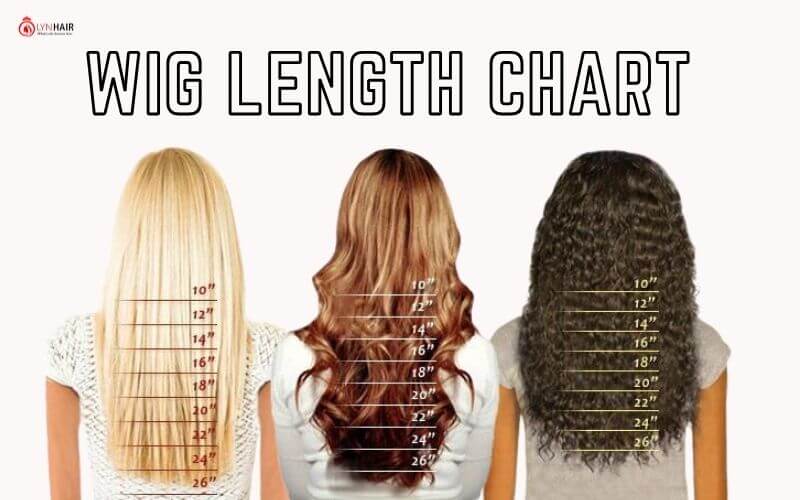Uncategorized
Wig Length Chart: Guide to Choose Your Perfect Hair Length
When it comes to picking the perfect wig, it’s not just about the texture, color, cap, and materials—it’s also about the length! Wig lengths bring their unique flair to your appearance. But, do you really understand the wig length? How to choose the right for yourself? In this guide, we’ll present to you a deep knowledge about wig length chart, the various hair lengths available, show you where they fall, and provide tips to ensure you choose a wig length that makes you shine. Let’s get started now!
1. The range of hair wig length chart
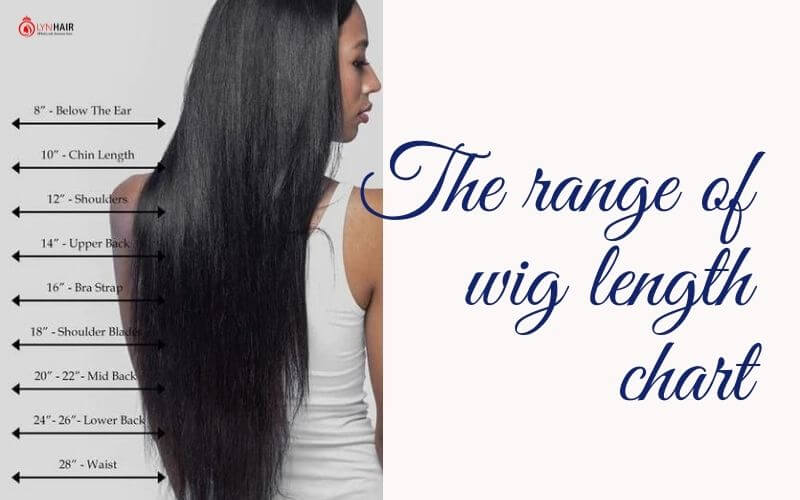
Wigs do commonly come in a range of lengths, with 8 to 32 inches being the typical spectrum. While lengths from 12 to 24 inches are indeed some of the most popular and versatile choices for many people. They offer a wide range of styling options, from shorter styles like bobs and layers to longer and more flowing styles like cascading curls and waves. These lengths are often preferred because they closely resemble the most common natural hair lengths, making them a comfortable and manageable choice for many individuals, whether they are new to wearing wigs or experienced wig enthusiasts.
2. Categories of wig length chart
Wig lengths are typically categorized into several main groups based on the length of the hair. Here’s a basic chart that outlines these categories:

Short Wigs:
- Pixie Cut: Very short, usually around 2-4 inches in length.
- Bob Cut: Short, typically around 6-12 inches, with variations from chin-length to shoulder-length.
Medium-Length Wigs:
- Chin-Length: Hair falls to the chin, around 12 inches in length.
- Shoulder-Length: Hair reaches the shoulders, typically around 12-16 inches.
- Collarbone-Length: Hair falls to the collarbone area, around 14-18 inches.
Long Wigs:
- Mid-Back Length: Hair extends to the middle of the back, around 18-24 inches.
- Waist-Length: Hair reaches the waist or slightly below, around 24-30 inches.
- Hip-Length: Hair extends to the hips, typically around 30-32 inches.
Extra-Long Wigs:
- Tailbone-Length: Hair falls to the tailbone or lower back, around 32-38 inches or more.
- Classic-Length: Hair reaches classic length, around 38-40 inches or longer.
3. Wig Length Chart
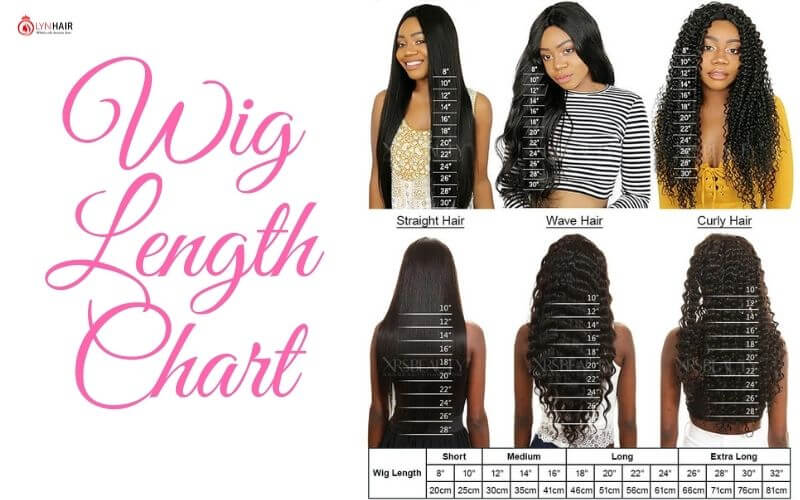
To provide you with a clearer understanding of how each of the mentioned hair lengths might suit you, we’ve incorporated a wig length chart that illustrates the placement of each length on your body. This will assist you in determining if a specific length is suitable for your needs.
4. Understand wig length chart
Understanding wig length is crucial when selecting the right wig for your needs. It’s measured in a precise manner, and comprehending the process can aid in choosing the perfect wig length. Typically, wig sellers measure the length from the roots of the hair to the ends. While this might appear straightforward, it can become somewhat perplexing when you take into account the various textures of wigs available. Different textures, such as curly, wavy, or straight, can affect how the length is perceived, so it’s essential to consider both the measurement and the texture when determining your ideal wig length.
5. Different lengths of wigs base on textures

Wig lengths can vary in appearance based on the texture of the hair. Here’s a breakdown of how different textures can affect the perceived length of wigs:
Wig length chart straight
Straight wigs tend to maintain their length consistently because the hair strands are aligned in a straight pattern. If you order a specific length, it will generally measure very close to that length from root to tip.
Wavy wig length chart
Wavy wigs may appear slightly shorter than their actual measured length when worn in their natural state. The natural waves in the hair can cause it to look shorter. Consider this when choosing the desired length for your wavy wig.
Curly wig length chart
Curly wigs can have the most significant difference in perceived length. The tight curls in the hair can make the wig appear significantly shorter than its measured length. Be prepared for a shorter look when opting for curly wigs.
6. How to Know Your Wig Hair Length is True?
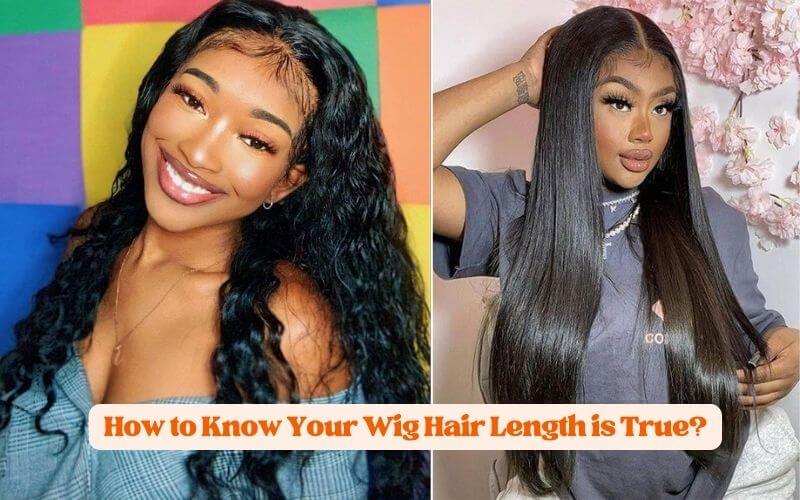
To check if your wig is true to length:
- Measure the wig: Use a soft measuring tape or ruler to measure the wig with the hair fully stretched out. Start from the roots and extend to the tips. Compare this measurement to the advertised length.
- Inspect the wig: A good-quality wig should have consistent thickness from root to tip, meaning most hairs are the same length. Thinner or uneven ends may indicate shorter hair has been used, affecting the overall length.
7. How to Measure Wig Length
Before diving into how to measure your wig’s length, it’s essential to understand one crucial aspect. The length indicated on a wig’s packaging signifies the hair’s length when the wig is worn. In particular, it measures from the crown of your head to the end of the longest strand while the wig is on. For instance, if you’ve purchased a 12-inch wig, an accurate measurement, if the wig is true to length, should yield 12 inches.
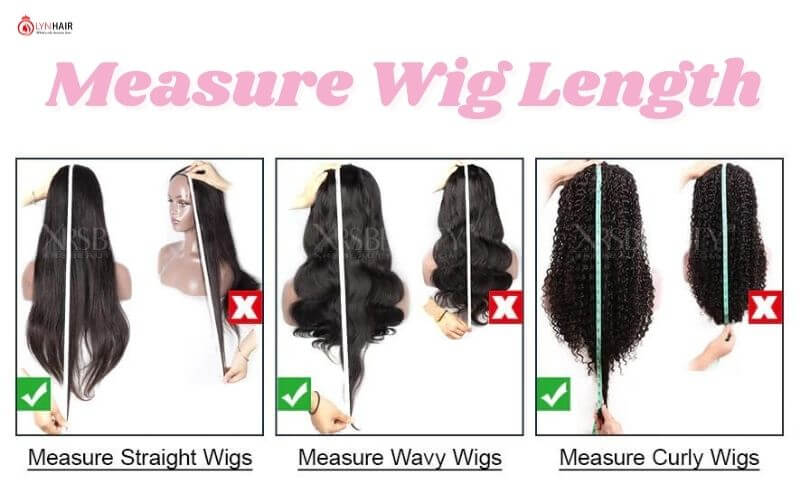
Here’s a simplified three-step guide on how to measure your wig’s length:
- Prepare Your Wig:
- Place your wig on a mannequin head, positioning it as you would when wearing it. Avoid laying the wig flat on a table, as this can lead to inaccurate measurements. Do not flip the wig over.
- Start the Measurement:
- Take a soft measuring tape and begin at the crown of the mannequin’s head, right where the hair begins. Make sure to start your measurement from the end that begins at 0 inches on the tape. This ensures you’re measuring from the correct point.
- Place the measuring tape precisely where the top of the head begins to slope downward. This is your starting point for measuring the wig’s length.
- Measure Downward:
- Holding one end of the measuring tape at the crown, guide the tape straight down the back of the wig, following the natural flow of the hair.
- If the hair is not completely straight, gently stretch it out with your hand as you measure to get an accurate length.
- The measurement you obtain by doing this represents the length of the wig, from the crown of the head to the end of the longest strand, while the wig is worn.
8. What is the most common hair wig length?

The popularity of wig hair lengths can indeed vary, but the range of 18 to 22 inches are currently considered among the most popular. These lengths offer a balance of being long and full, providing volume and versatility while still being manageable in terms of care. They are particularly well-suited for creating full and glamorous looks for special occasions.
9. How to Choose the Best Wig Length for yourself?

- How to Choose the Best Wig Length for yourself
Choosing the best hair length, whether it’s for your natural hair or a wig, depends on various factors, including your face shape, personal style, lifestyle, and preferences. Here are some tips to help you determine your ideal hair length:
- Desired Look: Determine the specific look you want to achieve with your wig. Whether it’s a short, chic bob or long, flowing locks, your desired appearance is a crucial factor in selecting the right length.
- Face Shape: Consider how the wig length complements your face shape. Different lengths can accentuate or soften your facial features. For example, longer lengths can elongate a round face, while shorter styles may suit square faces.
- Hair Texture: The natural texture of the wig’s hair (straight, wavy, curly) can impact how the length appears. Keep in mind that wavy and curly textures can appear slightly shorter when worn naturally.
- Density: The density of the wig matters. Higher-density wigs tend to maintain fullness throughout their length, while lower-density wigs may not. Choose a density that aligns with your preferred style.
- Lifestyle: Consider your daily activities and lifestyle. Shorter wigs can be more practical for active individuals, as they don’t interfere with activities like exercise.
- Maintenance: Shorter wigs often require less maintenance and styling compared to longer ones. If you prefer a low-maintenance option, shorter lengths may be ideal.
- Experimentation: Don’t hesitate to experiment with different wig lengths. Trying out various lengths can help you discover which one complements your overall appearance and style preferences best.
10. Conclusion
In the world of wigs, the choice of hair length is a powerful form of self-expression. It’s not merely about picking a number; it’s about crafting your unique style and embracing the beauty that resonates with you. With the insights provided in this comprehensive “Wig Length Chart: Guide to Choose Your Perfect Hair Length,” you are now equipped to make an informed decision.
Whether you opt for the elegance of a longer length, the chic allure of a bob, or the convenience of a shorter style, your choice should empower you to step into the world with confidence and grace. Remember to consider your face shape, lifestyle, and personal style preferences as you explore the myriad possibilities.
𝑭𝒐𝒓 𝒎𝒐𝒓𝒆 𝒊𝒏𝒇𝒐𝒓𝒎𝒂𝒕𝒊𝒐𝒏, 𝒄𝒐𝒏𝒕𝒂𝒄𝒕:
Whatsapp: +84.936.085.069
Follow us on Instagram: @lyn.hair_official and @lynhair.factory
Website: lynhair.com

